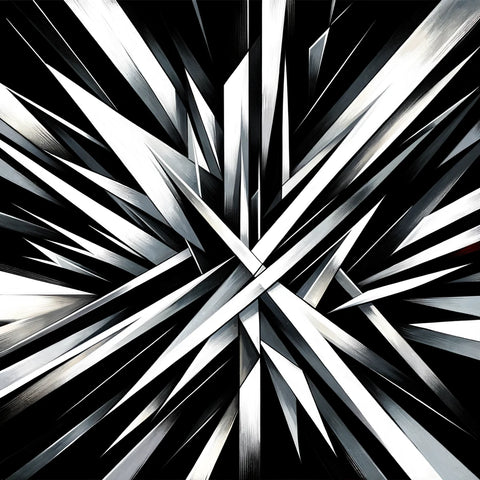The Essence of Minimalism
Minimalist black and white art strips away the distractions of colour to focus purely on form, texture, and the intrinsic emotions of the subject. Rooted in the minimalist movement of the 1960s, this style emphasises simplicity and objectivity, allowing the viewer to engage deeply with the artwork without the interference of complex colour schemes. By reducing art to its essential qualities, minimalism in black and white not only challenges both the creator and the observer to find meaning and complexity in seemingly straightforward compositions but also enhances the viewer's connection with the artwork.
In this form of art, every line, shape, and texture is deliberate, holding a specific function within the overall composition. The absence of colour removes preconceived emotional associations, focusing attention on the structural and textural elements of the piece. This not only invokes a timeless quality but also provides a universal language of visual simplicity that resonates broadly, encouraging viewers to reflect on the art and find personal interpretations.
Through minimalist black and white art, artists explore the power of less to express more, demonstrating that a reduction in form and colour can lead to an expansion in meaning and emotional impact. This paradox lies at the heart of minimalist philosophy, continuing to inspire artists and art enthusiasts alike.
Historical Context and Evolution
The origins of minimalist art are intertwined with the broader minimalist movement that began in post-war Western art. Artists like Frank Stella and Agnes Martin moved away from the expressiveness of abstract expressionism to a style that emphasised precision and simplicity. In photography, artists such as Ansel Adams and Robert Mapplethorpe explored the power of black and white images to convey profound beauty and stark reality without the need for colour, influencing countless artists in the process.
As digital technology evolved, so too did the approach to black and white minimalism. Modern artists have embraced digital tools that allow for even greater precision and manipulation of light and shadow, pushing the boundaries of what can be achieved in minimalist compositions.

Techniques and Materials
In minimalist black and white art, the techniques and materials used are as varied as the artists themselves. Traditional painters might choose acrylics or oils to create different textures, while photographers often manipulate light and shadow to enhance the visual impact of their images. Digital artists, on the other hand, might use software to strip down their graphics to the most basic elements of design.
Regardless of the medium, the common thread is a focus on reducing the artwork to its necessary elements. This often involves a painstaking process of subtraction, where every stroke, shade, or pixel not only serves a purpose but also enhances the overall harmony and balance of the piece.
Psychological Impact and Viewer Engagement
The stark contrasts and clean lines of minimalist black and white art can have a profound psychological impact on viewers. The absence of colour forces the audience to focus on other aspects of the art, such as the interplay between light and dark or the varying textures that might go unnoticed in more vibrant works. This can evoke a meditative state, where the viewer is drawn into a deeper contemplation of the artwork.
Furthermore, the simplicity of black and white minimalism allows for a more universal interpretation, making it accessible to a wider audience. This universality also enables the art to transcend cultural and linguistic boundaries, making it a powerful tool for conveying universal themes and emotions.
Notable Artists and Influential Works
Throughout the years, many artists have made significant contributions to the field of minimalist black and white art. From the sculptural works of Barbara Hepworth to the photographic compositions of Michael Kenna, each artist brings a unique perspective to the minimalist ethos. The works of Hiroshi Sugimoto, for instance, with his long exposure photographs of seas and theatres, invite viewers to explore the concept of time and memory, while Bridget Riley’s optical art challenges perceptions of space and depth.

The Future of Black and White Minimalism
As we move forward, the exploration of minimalist black and white art continues to evolve with new technologies and materials. Interactive installations and digital media offer new ways for artists to explore the principles of minimalism, engaging audiences in dynamic and immersive ways.
Furthermore, as the world becomes increasingly complex and cluttered, the clean lines and simplicity of minimalist art offer a visual sanctuary for those seeking calm and clarity in the chaos. This enduring appeal ensures that black and white minimalism will remain a vital part of the art world for years to come.
Conclusion
Minimalist black and white art, with its deep roots and enduring presence, continues to captivate and inspire. By focusing on the basics of form and contrast, it challenges viewers to find beauty and meaning in simplicity, proving that within the shades of silence, there lies a profound depth waiting to be explored.
Discover More at Home Art Haven
At Home Art Haven, we celebrate the profound depth and simplicity of minimalist black and white art. Our collections, such as Black & White Wall Art and Abstract Wall Art, showcase pieces that embody the spirit of minimalism, offering viewers a chance to engage deeply with the nuanced art of reduction. Explore our selections to find artworks that not only enhance your space but also provoke thought and invite contemplation, adding a timeless elegance to your environment.




















